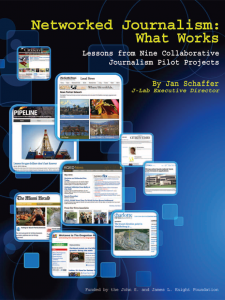November 27, 2012
Jan Schaffer
hard copy, online and pdf
What people are saying:
“…an excellent, must-read study.”
“Transformative”
“Paradigm-changing”

Three years ago, eight legacy newspapers and one public radio station were invited to partner with at least five independent news efforts in their community for at least a year. Now the results – and lessons learned – are in. The nine hub newsrooms grew their networks from 44 partners to 169. Final score: five wins, two hits, two losses. The project was funded by the Knight Foundation.
“I was enthusiastic about this, but I had no idea of how transformative this would be for us,” said David Shribman, editor of the Pittsburgh Post-Gazette, which launched the Pipeline site to cover fracking. “It changed the center of gravity for our whole organization.”
Said Seattle Times Editor David Boardman, “I think this program . . . has been hugely, hugely paradigm-changing for our newsroom and for me, individually.”
Bottom line: At its height, the nine hub newsrooms had grown their networks from 44 partners to 169; 146 partners are still participating.
We’ve learned, however, that all networks are iterative: Partners come and they go. Some divorce the network, some die in an emerging news ecosystem that is still quite fragile. Indeed, only two of the projects still have the identical partners they launched with.
The overall score: Five wins, two hits and two losses.
Two key takeaways: Content sharing overall can be a win-win for both legacy newsrooms and indie start-ups. Revenue sharing, however, is still a nut to be cracked.
Download the report (pdf).






